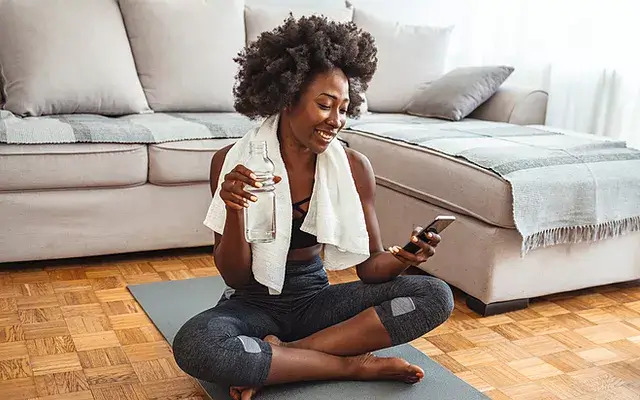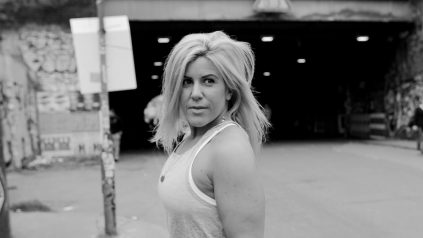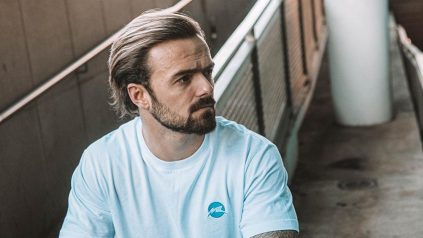Welcome to another instalment of our ongoing interview series, Making Gains.
At Insure4Sport, we love speaking to industry professionals to get their insights into what it takes to reach the top and stay there.
We recently brought you an interview with Laura ‘Biceps’ Hoggins from London’s Foundry Gym – give that a read if you haven’t already.
For this next instalment, we’re sitting down with Andrea Wallace. Andrea is an experienced personal trainer, fitness instructor, and – after competing in Los Angeles – a WBFF Pro Fitness model.
Andrea founded Sweat in the City in 2015, an online and in-person fitness company offering one-to-one personal training and fitness classes in the UK. Today, she has more than 100 members taking part in her live Team Fit online workouts.
In 2017, she also created the Soca Fitness Fete, hosting regular fitness party events with more than 200 attendees at a time.
We asked Andrea about her career, her experiences, and how she juggles competitions with the day-to-day running of a fitness business. Read on to find out what she had to say.

1. Tell us about your career leading up to the present day and your work with Sweat in the City – what was your background, and where did you draw your inspiration?
I’ve always been interested in fitness, but when I joined a gym at 16, that’s when my real passion for all things fitness truly started. Before I turned 16, I was inspired by the likes of Cindy Crawford and Reebok Step. I used to follow their workouts on video cassettes (remember them?!)
I did that two or three times a week after school and ate healthily, too, inspiring my family to do the same. Fast-forward 20 years, and after becoming a personal trainer and fitness instructor in gyms, and having competed in numerous fitness competitions, I decided to create my own class: Sweat in the City and hired a studio in London.
My twenty years in the industry taught me that my passion is motivating people, both to keep fit and eat well at the same time. For the first 18 months of Sweat in the City, I taught my own fitness class while imagining some kind of event that could combine my ‘party life’ with working out.
This is when the idea for the Soca Fitness Fete first came to life. I hosted eight events over three years, with each one getting bigger – we ended up with 200 people in the venues.
Over lockdown, we switched solely to online workouts, and currently have more than 100 members.
2. Talk us through a typical day in your life as a personal trainer.
I like to prepare my sessions the day before I meet with clients. After I wake up, I usually eat my breakfast before I get ready, and then I eat again before I leave the house to see a client. This meal will probably be a smoothie or some kind of rice cake snack with a few toppings.
I always take my lunch with me in Tupperware, too, as well as my two-litre water bottle (which I don’t go anywhere without).
I try to schedule two or three clients throughout the day. These can be online, in my studio, or I meet them at their house or a local park. I then come home to prepare for the next day.
3. You’ve participated in many fitness competitions – how do you prepare for them, and what was your experience in Los Angeles like with the WBFF?
I had no idea how to prepare for my first competition. I thought I just had to work out in the gym and eat healthily. My body was naturally fit anyway from years of going to the gym.
I didn’t know about ‘shredding’ until I was at the venue of my first competition and saw the other competitors. I knew I looked fit, but they were just on another level. So, through speaking to them, I learned about their competition coaches, which are completely different to your usual personal trainers.
They explained the whole ‘shredding’ process, including the number of meals they had to eat in the run-up to a competition. Nevertheless, I still got on the stage that day. I didn’t place, but I gained invaluable insight into the fitness competition world. As soon as that one finished, I signed up for the next one, which was just five weeks away.
To train for this one, I found a highly-recommended competition coach, Gabriel Sey, and we got to work together, following a certain diet for my body type. I’d never drunk so much water in my life, but it was necessary to shred for the final days. I came third in that competition.
Eventually, I decided to sign up for a competition in Los Angeles. I’d never been to LA before, and I absolutely loved it. I travelled on my own so that I didn’t have any distractions while there. I rented a room on Airbnb and continued to follow my shredding plan for the last couple of days before the competition – it was the best experience of my life!
I shared a dressing room with a lovely lady from New York with whom I’m still friends today. I won in my category and was just so overwhelmed – I had become a WBFF Pro in a major competition in LA!
4. What have been the biggest challenges in your career, and how have you overcome them?
The biggest career challenge for me has been getting to grips with social media. From a business perspective, it has become the best way to promote my services and me.
But, my first love is fitness and motivating people – admin isn’t. So, I’ve had to learn to organise my calendar and make time for social media work, too.
5. What is your proudest career moment to date?
We’ve mentioned it before, but my proudest moment is becoming a fitness pro with the WBFF in LA and following the strict eating regime that surrounded it.
Besides this, organising and hosting successful fitness parties and classes around London also makes me very proud.
6. What are the five most successful marketing strategies you have used for Sweat in the City?

I would say:
- Learning to master one social media channel at a time. There are so many to choose from but just stick to one to begin with, and build a good following on there first
- Creating a user-friendly website so I’m easily contactable. Clients always want more information, so a website is an easy source
- Building my email marketing list
- Getting testimonials added to my website
- Promoting what I do
7. How much has your personal brand helped Sweat in the City thrive?
My personal brand has, without doubt, helped Sweat in the City to thrive – not just because of the number of followers I have, but mainly because I lead by example.
I’m promoting a fitness brand, and I, myself, live by the same rules that I teach others – that’s very important. Although I like to keep my personal life private, having a personal brand helps others learn more about you and what you’re about.
8. What is The Fitness Bootcamp – and what should a first-timer expect?
The Sweat in the City Fitness Bootcamp is a 75-minute outdoor workout that other instructors and I teach in the park during spring and summer.
It’s similar to the fitness parties I host with Sweat in the City, but outdoors, so we have a live DJ playing club tunes, too.
We start with a cardio workout, then move into circuit training with resistance equipment, finishing off with team games which are usually the highlight of the session.
A first-timer to the Fitness Bootcamp will realise that working out doesn’t always have to feel like ‘hard work’, especially when you hear the music pumping and everyone around you is motivating one and other, laughing and generally having fun.
They’ll definitely feel how hard they’ve worked for the next few days afterwards, though!
9. How do you make sure you retain your clients?
After every event I host, I always send out feedback forms to attendees to find out what people liked and what I can do better next time.
I also make sure I make myself easily contactable, especially for the Team Fit online members, just in case anyone has any queries, and I try to respond to clients on the same day.
As a personal trainer, your clients need to know they are cared for and appreciated. So, I truly value every follower, attendee and class member.
10. What’s the most important piece of advice you’d give to a newly qualified personal trainer?
The most important thing is to keep learning. There are various elements to fitness and so many different kinds of people, so it’s good to get lots of knowledge behind you.
Learn from other trainers, too, by attending their classes and training with others in the same situation as you. I’d recommend training different types of people, too, so that you become more versatile for future clients.
Also, be easy to contact, but make time for yourself and make sure you eat well. Lead by example.
11. How important is having insurance as a personal trainer?
Having personal trainer insurance is very important because, without it, one accident could mean the end of your career.
If someone gets injured or equipment gets damaged during one of your sessions, and you’re not insured, you could find yourself out of pocket for a long time. Insurance will also cover YOU in the event of injury.
When your clients know you have the right insurance, they will know you are serious about what you do and will come to you with full trust. It’s good to be prepared for all eventualities.
Many thanks to Andrea for her insights!
You can follow her on Instagram at @fit.withange and visit the Sweat in the City website here.
Specialist personal trainer and facilities insurance from Insure4Sport
If you dream of making your own gains as a personal trainer like Andrea, you need to make sure you’re insured first.
At Insure4Sport, our specialist insurance for personal trainers and sports facilities are designed to protect you, your equipment, gym, staff, and customers.
Our insurance protects you if your equipment is lost, damaged, stolen, and in the event of an injury claim made against you during a session.
Click the button below to learn more about how our specialist insurance can help you and get a quote in minutes.
Related
Making Gains: Laura ‘Biceps’ Hoggins







